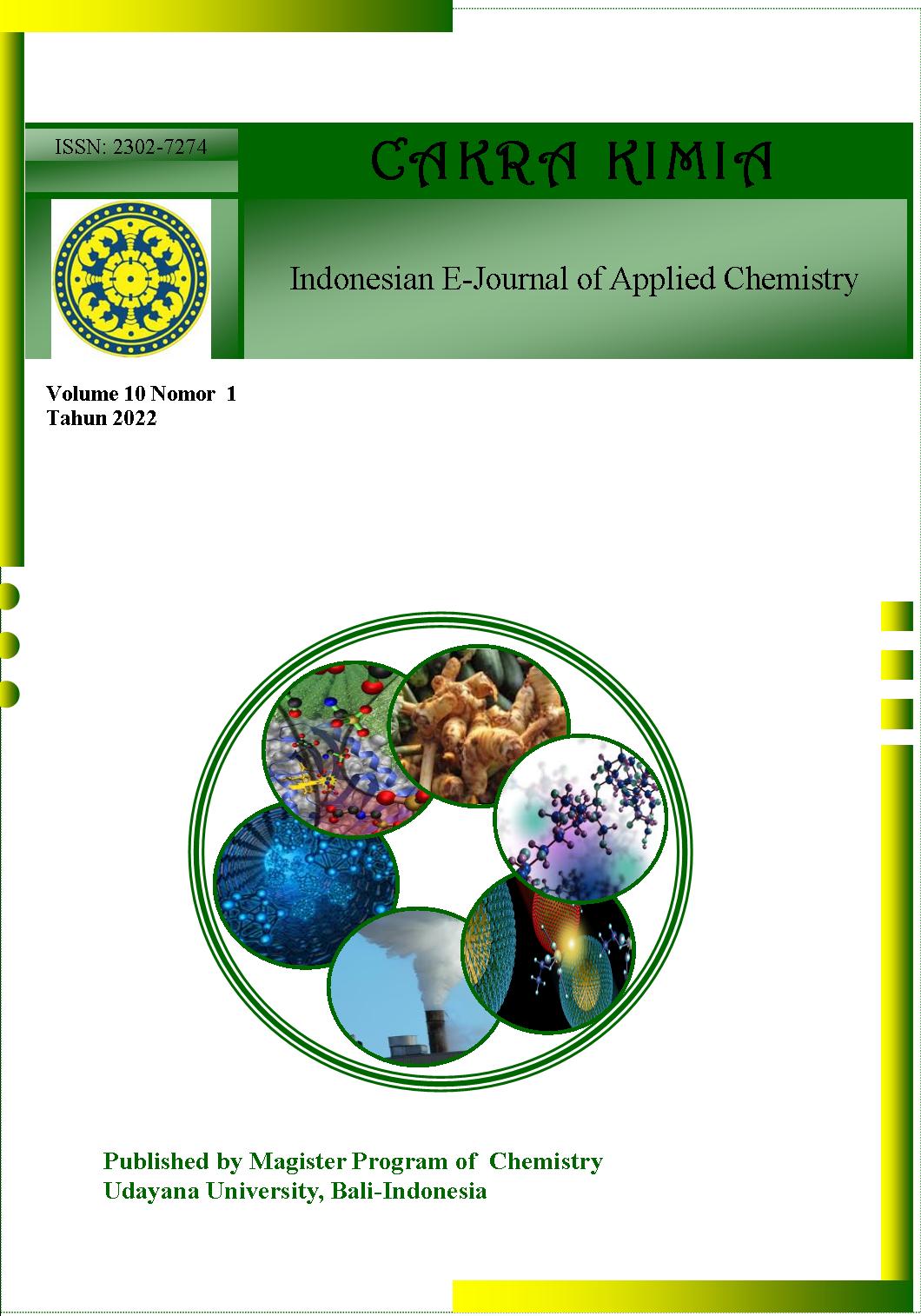BIOSINTESIS NANOPARTIKEL EMAS MENGGUNAKAN EKSTRAK AIR BUAH ANDALIMAN (Zanthoxylum acanthopodium DC.)
Abstract
ABSTRAK: Sintesis hijau nanopartikel emas (NPAu) yang dimediasi ekstrak tumbuhan saat ini mendapatkan minat besar di bidang nanoteknologi. Dalam penelitian ini, NPAu disintesis menggunakan ekstrak air buah andaliman (Zanthoxylum acanthopodium DC.). Pembentukan NPAu dikonfirmasi dengan mengamati perubahan warna larutan dari bening menjadi cherry red. Parameter yang dioptimasi pada penelitian ini adalah konsentrasi ekstrak air buah andaliman dan rasio campuran ekstrak air buah andaliman dengan larutan HAuCl4. Nanopartikel emas dikarakterisasi menggunakan spektrofotometer UV-Vis, SEM-EDS dan PSA. Dari hasil karakterisasi, NPAu memiliki panjang gelombang maksimum 540-559 nm, morfologi NPAu berbentuk kristal bulat dimana komposisi tertinggi NPAu adalah emas sebesar 36,01% dan ukuran NPAu tersebut rata-rata di bawah 100 nm.
ABSTRACT: Plant extract-mediated green synthesis of gold nanoparticles (AuNPs) is currently gaining great interest in the field of nanotechnology. In this study, AuNPs were synthesized using an aqueous extract of andaliman fruit (Zanthoxylum acanthopodium DC.). The formation of AuNPs was confirmed by observing the color change of the solution from clear to cherry red. The reaction parameters such as the concentration of andaliman fruit water extract and the ratio of the mixture of andaliman fruit water extract with HAuCl4 solution were optimized for AuNPs biosynthesis. Gold nanoparticles were characterized using UV-Vis spectroscopy, SEM-EDS and particle size analyzer. From the characterization results, AuNPs have a maximum wavelength of 540-559 nm, the morphology of AuNPs is spherical crystals where the highest composition of these AuNPs is gold at 36.01% and the size of these AuNPs is below 100 nm on average.
Downloads
References
[2] Nilufar Torabi, Azin Nowrouzi, Ali Ahadi, Safoura Vardasbi, Behrouz Etesami, Green synthesis of gold nanoclusters using seed aqueous extract of Cichorium intybus L. and their characterization, SN Applied Sciences, 1, 9, 2019, 981 https://d0i.0rg/10.1007/s42452-019-1035-x
[3] Boisselier, E., and Astruc, D. Gold Nanoparticles in Nanomedicine: Preparations, Imaging, Diagnostics, Therapies and Toxicity. Chem. Soc. Rev., 38, 1759-1782, 2009
[4] Merza, K.S., H. D. Al-attabi, Z. M. Abbas, and H. A. Yusr. Comparative Study on Methods for Preparation of Gold Nanoparticles. Green Sustain. Chem., vol. 2, 26– 28, 2012
[5] Kulkarni, A. & Bhanage, B. M. 2014. Ag@AgCl Nanomaterial Synthesis Using Sugar Cane Juice and Its Application in Degradation of Azo Dyes. ACS Sustainable Chem Eng, 2, 1007−1013, 2014. http://doi.org/10.1021/sc400566
[6] Akilandaeaswari, B., K. Muthu. Green Method for Synthesis and Characterization of Gold Nanoparticles Using Lawsonia inermis Seed Extract and Their Photocatalytic Activity. Materials Letters, 2020 doi: https://doi.org/10.1016/j.matlet.2020.128344
[7] Satpathy, S., A. Patra, B. Ahirwar, M.D. Hussain. Process optimization for green synthesis of gold nanoparticles mediated by extract of Hygrophila spinosa T. Anders and their biological applications. Physica E: Low-dimensional Systems and Nanostructures, 2019 doi: https://doi.org/10.1016/j.physe.2019.113830
[8] Akhtar, M. S., Panwar, J., & Yun, Y. S. Biogenic synthesis of Metallic Nanoparticles by Plant Extracts. ACS Sustainable Chemistry and Engineering, 1, 6, 591–602, 2013 https://doi.org/10.1021/sc300118u
[9] Singh, A., Jyoti, K. Green synthesis of nanostructured silver particles and their catalytic application in dye degradation. Journal of Genetic Engineering and Biotechnology 14, 311-317, 2016
[10] Lembang, M. S, Sintesis Nanopartikel Emas dengan Metode Reduksi Menggunakan Bioreduktor Daun Ketapang (Terminalia catappa), Program Studi Kimia FMIPA, Universitas Hasanuddin, 2014
[11] M. Amiruddin, T. Taufikurrohmah, Sintesis dan Karakterisasi Nanopartikel Emas Menggunakan Matriks Bentonit sebagai Material Peredam Radikal Bebas dalam Kosmetik, Journal of Chemistry 2, 1, 2013
[12] H. Sarwina, M. Zakir, S. Dali, Pemanfaatan Fraksi Etil Asetat Daun Ketapang (Terminalia catappa) sebagai Bioreduktor dalam Sintesis Nanopartikel Emas dan Analisis Sifat Antibakterinya, Jurnal Universitas Hasanuddin, Makassar, 2015
[13] M. Zakir, T. Sekine, T. Takayama, H. Kudo, M. Lin, Y. Katsumura. Technetium(IV) Oxide Colloids and The Precursor Produced by Bremsstrahlung Irradiation of Aqueous Pertechnetate Solution. J. Nucl. Radiochem. Sci, 6, 3, 243-247, 2005
[14] M.W. Hidayat, Sintesis Nanopartikel Emas Menggunakan Bioreduktor Ekstrak Buah Mengkudu (Morinda citrifolia L.) Dengan Irradiasi Microwave, Program Studi Kimia, Universitas Islam Negeri Maulana Malik Ibrahim, 2019.



 Petunjuk Penulisan
Petunjuk Penulisan
